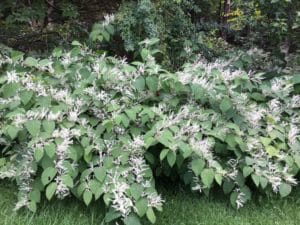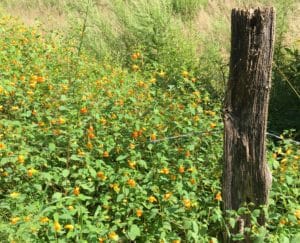Hello, fellow lovers of all things green,
“Is there such a thing as wild hydrangea?” asked Tammy of Marshalls Creek, PA. There is. Hydrangea arborescens is commonly known as Smooth Hydrangea or Wild hydrangea, and it’s native to the woodlands of the northeast, but it blooms in the spring. The plant Tammy notices gracing roadsides this time of year is Japanese knotweed, also called Asian Knotweed, which tells its origin. It’s a showy, white, lacey plant from late summer into fall with white sprays covering shamrock green smooth-edged leaves. Though shrub-like, Fallopia japonica is not a woody plant but a hefty herbaceous perennial in the buckwheat family. Its hollow stems look bamboo-like, growing ten to thirteen feet yearly. Sadly, it’s invasive, though pollinators are pleased with the plethora of plumes.
Knotweed and Jewelweed are September Roadside Beauties
Some call it Fleece Flower, Monkey Weed, or Donkey Rhubarb. They say it tastes like very sour rhubarb, and you’d have to be dumb as a donkey to eat it. The thing is, donkeys aren’t dumb. They are pretty smart but indeed stubborn. We can’t blame an animal for digging in its heels to protect itself.
Another wild beauty is Orange Jewelweed, also known as Spotted Jewelweed. I look forward to seeing this annual North American native along streams, creeks, and trenches roadside. Native Americans used the leaves juice as a poison ivy rash remedy. They grow three to five feet tall and have almost see-through and succulent-like stems. The flower’s shape reminds me of foxgloves, though they dance on the tips rather than ride all along the stems.
Upon researching Impatiens capensis, I learned about a unique feature that earned its other common name, Touch-me-not. When the inch-long seed pods ripen, they explode! With just a light touch, the pods promptly peel back and fling out tiny seeds. Whoever thought plants could be such fun!
Garden Dilemmas? AskMaryStone@gmail.com and your favorite Podcast App.
There’s more to the story in the Garden Dilemmas Podcast (12 soothing minutes):
Here’s a link to a video demonstrating Jewelweed seed pod fun! https://www.youtube.com/watch?v=FJ_vxAZZ–4
Column Updated 9/16/24





